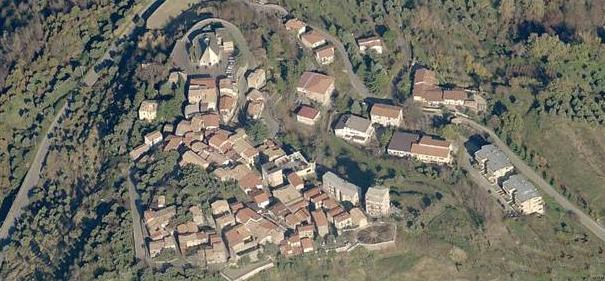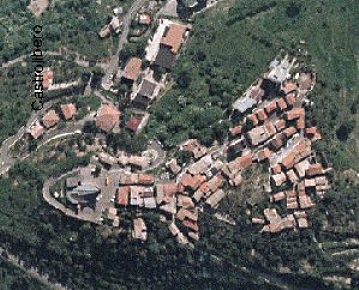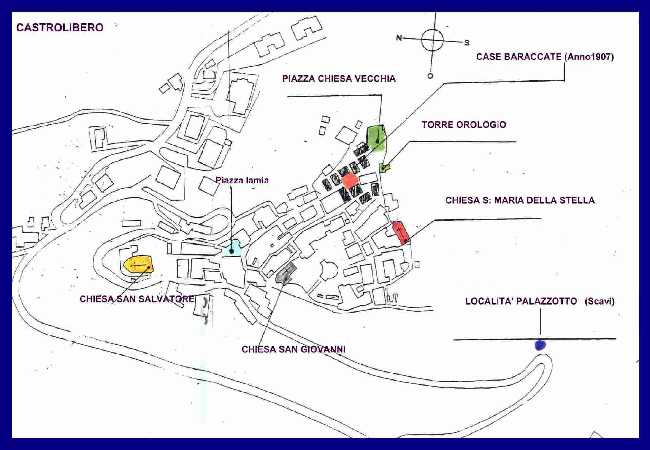Calabria in Italy
This is english
version
![]()
Study
of the search for the site of the mythical city of Pandosia in valley of the Crati
River
This
part of the History of Castrolibero has been translated in English thanks to
Mr.
Louis Ponsi - Timonium, Maryland, USA
- that
I publicly thank.

Edited
by Alberto Anelli
Click Here for italian Version
Study of
the search for the site of the mythical city of Pandosia in valley of the Crati
River
The town of Castrolibero is located, according to many authors, in
the place where the mighty fortress of Pandosia once rose. There the mythical
city of the Enotri would be located, drawing its name from the great fertility
of the soil: "Gifted City". Pan watched over it, son of Mercury, god
with cloven hoofs, inventor of the flute and lover of every depravity.
The
name of Italy is due to the son of Enotro. In fact during that era the Calabria
of today was called Italy and the Salentina peninsula (heel of the boot) was referred
to as Calabria.
Tito Livio, narrated in his History that during a siege
near the walls of Pandosia (332 BC), Alexander Molosso, King of Epiro and uncle
of Alexander the Great lost his life.
Part of Molosso's corpse, horrendously
mutilated, was carried off to the near-by city of Cosenza, where it was subjected
to unspeakable cruelty.
During the period that the Sibari and Crotone
were predominant, Pandosia managed to preserve its political and economic autonomy,
as testified to, among other things, by its valuable and rare coinage.
Subsumed
into the great Roman Empire, Pandosia was subsequently destroyed by the fury of
the Barbarian. (Notary Iacoe 1651 manuscript).
It is spoken of again
in 868AD, when the King sent the Count of Bergamo Ottone to Calabria, to oppose
the Emir of Amantea and his Saracens. The Saracens, leading an army of Franks,
and joined by the bishops Hoschisio and Gheriardo, built a fortification right
on the hill where the fortress of Pandosia once stood. From then on, the place
was called "Castro-franco", i.e., "encampment of the Franks".
Castelfranco (now Castrolibero) was a fortified place for a long time
(according to ancient legend, in the XI century Roberto the Guiscardo built a
castle there to rule over the valley of the Crati River). The civil life of the
population of that time was carried out in 2 neighboring small towns: Pantosa
(now partially in Marano Principato up to its border with Castrolibero) &
Veneri (now Castelvenere, in Castrolibero's Andreotta section).
After
a series of smaller feudal subjugations, Castelfranco ended up under the powerful
Sanseverino family of Bisignano (XV century). In 1487, as a consequence of what
history records as the "Conspiracy of the Barons", in which the Sanseverino
family participated, King Ferdinand ordered the Castelfranco town walls and houses
destroyed, because that fortress had created notable problems for the Aragonese
family of Cosenza.
In 1550 Pietro Antonio Sanseverino granted
as dowry to his daughter Eleonora, upon her marriage to the Marquis of nearby
Rende, the towns of Castelfranco and Cerisano, comprised obviously of all their
rights & even the vassals of every order and rank.
Between
1562 and 1566 the feudal domain of Castelfranco (Castrolibero) was acquired by
Valerio Telesio, brother of the noted philosopher Bernardino.
Oppressed
in various ways by their new feudal master, the vassals of Castelfranco did not
suffer the Baron's "yoke" for long. After an attempt against his son
Roberto that did not produce the effect hoped for by the castelfranchesi, on 10
August 1579, under circumstances that remain mysterious to this day, the inhabitants
of Castelfranco rose in a popular revolt that ended with the murder of Valerio
Telesio in the church of San Giovanni.
Castelfranco later passed
to the Sersale family, descendants of a prior owner of the fiefdom, which retained
it until the end of the XIX century AD.
Center of a "vendita carbonara"
[an early 19th century secret political society] led by the Parise brothers, Castelfranco
actively participated in the revolutionary movements of the first half of the
19th century. In 1844 one of its citizens, Santo Cesario, born in San Fili but
resident of Castelfranco, was executed in the valley of Rovito for participating
in the revolutionary movement of 15 Mar 1844. Later, the Bandeira brothers were
executed in the same place.
After the Unification of Italy, King Vittorio
Emanuele II, with his decree of 26 March 1863, recognized the change of name from
Castelfranco to Castrolibero, as resolved by the local Decurionato (communal Council).
Struck
by several earthquakes over the centuries (1638, 1783, 1835, 1854), Castrolibero
endured an additional disaster during of the quake of September 8, 1905. On that
occasion, a Committee formed in Naples came to build 17 new houses in Castrolibero's
Historic Center.
To the Mayor of Naples, who attended the December
1, 1907 opening ceremony, a local orator, after praising the work and generosity
of the Neapolitans, wanted to address Castrolibero's ancient origins:
"Tell
Naples, Mr. Mayor, tell Naples, gentlemen of the Committee, that the voice of
thanks and gratitude is not that of a humble and obscure village, but is that
of the illustrious city which Pandosia once was said to be. Here coinage was minted,
here a Forum, here a Senate, here the double town-walls that made the city formidable
to its enemies, here when barbarians were everywhere else shined the sunlight
of civilization, science and art. Tell Naples thank you in the name of Pandosia".
Already well-known in the XV century for its many brick furnaces,
Castrolibero was always valued in antiquity for its excellent silk production.
After the two great wars (1915/1940) the shoemaking handicraft became extremely
disseminated. That earned Castrolibero its well-known name "town of shoemakers".
This
part of the History of Castrolibero has been translated in English thanks to Mr.
Louis Ponsi - Timonium, Maryland, USA
- that
I publicly thank.

Centro Storico di Castrolibero
(Foto 2005). La chiesa SS. Salvatore è a destra della foto
View of the Historical Center of Castrolibero
To your left the Church
St. Salvatore had built since 1972 to 1974 in the said place "Ahead
in church" really in front of the place "arrieti u castieddru"
(Behind the castle). Á. your right the plaza "Old
Church - Chiesa vecchia". Á. the center in the vegetation,
slightly moved toward your left, plaza is
St. Giovanni. In low, on the extreme right, the
"Palazzotto" and the round tower.

The map of the Historical
Center

Castrolibero
- Centro Storico - 2008

Castrolibero
- Centro Storico - "CAPO SOPRANO" - 2008

Castrolibero
- Centro Storico - "CAPO SOTTANO" - 2008
VISITS THE HISTORICAL CENTER- Photos
Castrolibero, March 2007
Alberto Anelli
L'Autore
si riserva di esercitare tutti i diritti editoriali - Pertanto non è consentito
copiare i contenuti di questo sito, se non indicandone espressamente la fonte
e l'autore.
Per la Collana Storia di Castrolibero, a cura di Alberto Anelli:
-
La Storia di Castrolibero in 20 pagine - Edizione Luglio 2007
-
Castrolibero - Il paese degli scarpari
- Il Terremoto dell'8 settembre
1905 a Castrolibero.
- Castrolibero 100 anni dopo il terremoto
del 1905.
- Storia della chiesa crollata nel 1905
in Piazza Pandosia di Castrolibero
- La Storia delle due chiese dedicate
a San Francesco nella frazione Santa Lucia
- Mappa della località Piazza Pandosia
nel 1970 (con foto degli anni 1956-1970)
- Il Palazzotto di Castrolibero - Storia,
mappe e foto
- La tragica fine di Valerio Telesio nella
rivolta popolare del 10 agosto 1579
